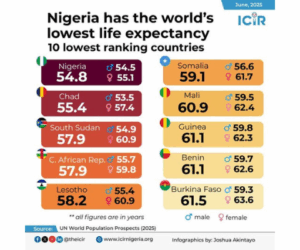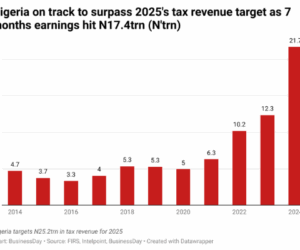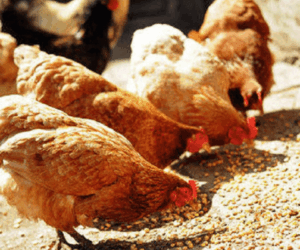…Farmers share how investors can minimise cost, boost food security
Catfish business, driven by insufficient local production, presents a significant investment opportunity with high profit potential and reduced risk, according to experts.
With over 45 percent of Nigeria’s fish consumption dependent on imports, experts highlight that strategic investments can help farmers to boost local production, maximise profits, and minimise costs.
Nigeria produces 1.07 million metric tons (mmt) of fish annually, the Central Bank of Nigeria (CBN) data say. Demand is estimated at 3.6 million tons, thereby leaving a gap of about 2.5 million tons. The gap is mainly met by imports.
Statista, an online data platform, estimates Nigeria’s fish market (including seafood) at $17.88 billion, which is N27.52 trillion. The National Bureau of Statistics (NBS) estimates local demand at N4.46 trillion, leaving a gap of N23.06 trillion.
Read also: Plateau farmers record bumper irish potato harvest despite insecurity
“There’s no better time to venture into the fish business if you know how to do it right because demand is very high, and local supply falls short of demand,” said Elizabeth Uloko, a Kaduna-based catfish farmer, during a phone conversation with BusinessDay.
Adetunji Samuel, who earned multiple awards and job offers from state governments during his National Youth Service Corps (NYSC) year, turned them all down to pursue catfish farming. Today, he runs one of Nigeria’s largest catfish farms.
“Fish is a daily requirement in most Nigerian households, and that is why its demand cannot decline. However, you must have the right skill sets to be able to maximise profits” he said. “We have a capacity of over two million fish, which is not even enough for the people of Plateau State, let alone neighbouring states,” he added.
A recent study supported by the Bill and Melinda Gates Foundation echoed this potential, stressing the urgent need to boost fish production to meet the country’s growing nutritional demands.
Nigeria’s per capita fish consumption is 11.3 kg—almost half the World Health Organization (WHO)’s global average of 21 kg—underscoring the scale of the opportunity for local producers.
“The country’s fish consumption per capita remains low, highlighting the urgent need to boost local production to meet nutritional needs—while also presenting a clear opportunity for investors to tap into,” the report stated.
Profitability of catfish farming
Catfish farming continues to prove its profitability in Nigeria as a 2024 study by Olaoye Jacob, a professor of Fisheries and Production Management alongside his research team, reported.
Another study entitled, ‘Profitability Analysis of Catfish Production in Odogbolu LGA, Ogun State,’ published in the Nigerian Journal of Agriculture and Agricultural Technology, revealed that an initial investment of N3,000,000 in fish production yielded a profit of over N700,000 in just six months.
For small-scale farmers, industry stakeholders estimate that an investment of N1.2 million in operational costs can yield profits of around N400,000 in five months —especially when raising 500 catfish to table size (at least 1kg).
Read also: Firm distributes 266,000 cocoa seedlings, 6,000 shade tree seedlings to farmers
The Akwa Ibom Fish Farmers Association of Nigeria (AKWAFFAN) ranks catfish farming among the top agribusiness opportunities in the country.
“On a scale of 1 to 10, I would rate the catfish business as eight in terms of profitability,” said Okon Amah, AKWAFFAN’s secretary and CEO of Provade Integrated Farms and Services.
“This is because fish farming can generate between 35 percent to 75 percent return on investment with the right knowledge, skills, and resources,” he added.
Among the various segments of the value chain, hatchery and smoked catfish sales stand out as the most lucrative.
“When it comes to fish farming, hatchery is the most profitable as 70 percent of feed cost is reduced,” noted Ekomafe Prosper, an Abuja-based fish farmer and CEO of Tejfarms.
“I sold about 500 pieces of smoked catfish in less than one week —the processed fish sold off faster,” said David Yaji, CEO of DavYaj Farms, based in Gwagwalada, Abuja.
Cost of investment
The initial investment cost in catfish farming depends largely on the scale of production, according to experts. Successful fish farming requires a reliable supply of clean, uncontaminated water and an available space.
The cost of acquiring a plot of land ranges from N500, 000 to N2,000,000, depending on the farm’s location. In addition to land, other essentials include a fish pond, fish feed, and nets.
“For a 500- capacity catfish farm, a mobile fish pond (made with tampauline) costs between N150,000 to N170,000, depending on your location,” said Okon, earlier quoted. “About 1 kg of feed is required to raise a fish to a table size of one kilogram — that’s 25 bags for 500 pieces, which costs between N750,000 and N1.2 million,” he disclosed.
“Fish feed takes about 70 percent of the operational costs,” noted Prosper. A 15 kg bag of local fish feed like BlueCrown sells for between N28, 000 and N36,000, depending on the pellet size (3mm, 6mm, or 9mm).
Stocking your fish pond costs between N100 and N150 per fingerling
“After production, one kilogram of fresh catfish goes between N3,500 to N4,500 in cities,” said Prosper. “Prices, however, vary between rural and urban areas,” added Uloko.
Okon however noted that catfish farming is a game of numbers. “ The larger the scale, the better the profit,” he stated.
Challenges in the sector
Nigeria’s catfish sector faces mounting challenges that threaten its growth, despite a massive investment potential.
Key issues include unstable feed prices, lack of technical know-how, market access, disease outbreaks, water quality management and export bans.
“Having access to a ready market for start-ups is usually a challenge,” said Prosper, earlier quoted.
“Also, fish feed prices are unstable due to the high cost of raw materials,” said Okon.
Read also: NEPC urges farmers in oil palm value chain to form clusters to boost businesses
Prosper also noted that many farms have shut down due to high input costs. A BusinessDay study confirms this trend, while World Bank data shows a 15 percent production decline—from 1.2 million tons in 2017 to 1.04 million in 2022.
“The lack of uniformity in pricing also leads to underpricing, as some farmers panic-sell for fear of incurring additional feeding costs,” Okon added.
On the export front, Nigeria continues to face setbacks. “The EU and U.S. bans on our fish products stem from failure to meet global standards and negligence by our regulatory agencies, ”he explained.
“All efforts to address these issues have seen little progress. Only a few fragmented businesses currently operate across the exports value chain,” Okon concluded.
How catfish farmers can thrive
Despite challenges in the fish farming sector, experts say investors can still succeed with the right strategies and skills.
“Before you start a fish farm, ensure you have a ready market, from restaurants, grocery stores, to open markets and large-scale buyers. This helps to prevent losses and reduces extra costs,” Prosper advised.
Okon emphasised the importance of preparation. “Buying in bulk and acquiring knowledge are key to thriving in the business. The right skills reduce risks of heavy losses, while bulk-buying helps to cut costs and avoid panic selling,” he noted.
To reduce feed expenses, Elizabeth recommended local alternatives. “Feeds like Bluecrown, Aller Aqua, and Ecofloat are far cheaper than imported options. They’re good substitutes after the first eight weeks of rearing fingerlings,” she noted.
Okon added that farmers can also explore unconventional feed sources. “Leftover bread, waste noodles, black soldier fly larvae, and earthworms can supplement regular feed. They’re not nutritionally complete but help to reduce costs when used occasionally.”
Proper hygiene is non-negotiable, Prosper stressed.
Read also: Unlocking Nigeria’s potato potential: Sustainable seed pathways for smallholder farmers
“Washing the fish pond weekly and changing the water daily reduce the risk of infection disease outbreaks.”
For those eyeing expansion, global standards are essential. Oluwatoyin Akintayo, global exports director at Wetin Dey Global, explained that “meeting international standards can turn local hustles into intercontinental brands.”
He added, “No matter how good your product is, it won’t cross borders without the right certifications.”









